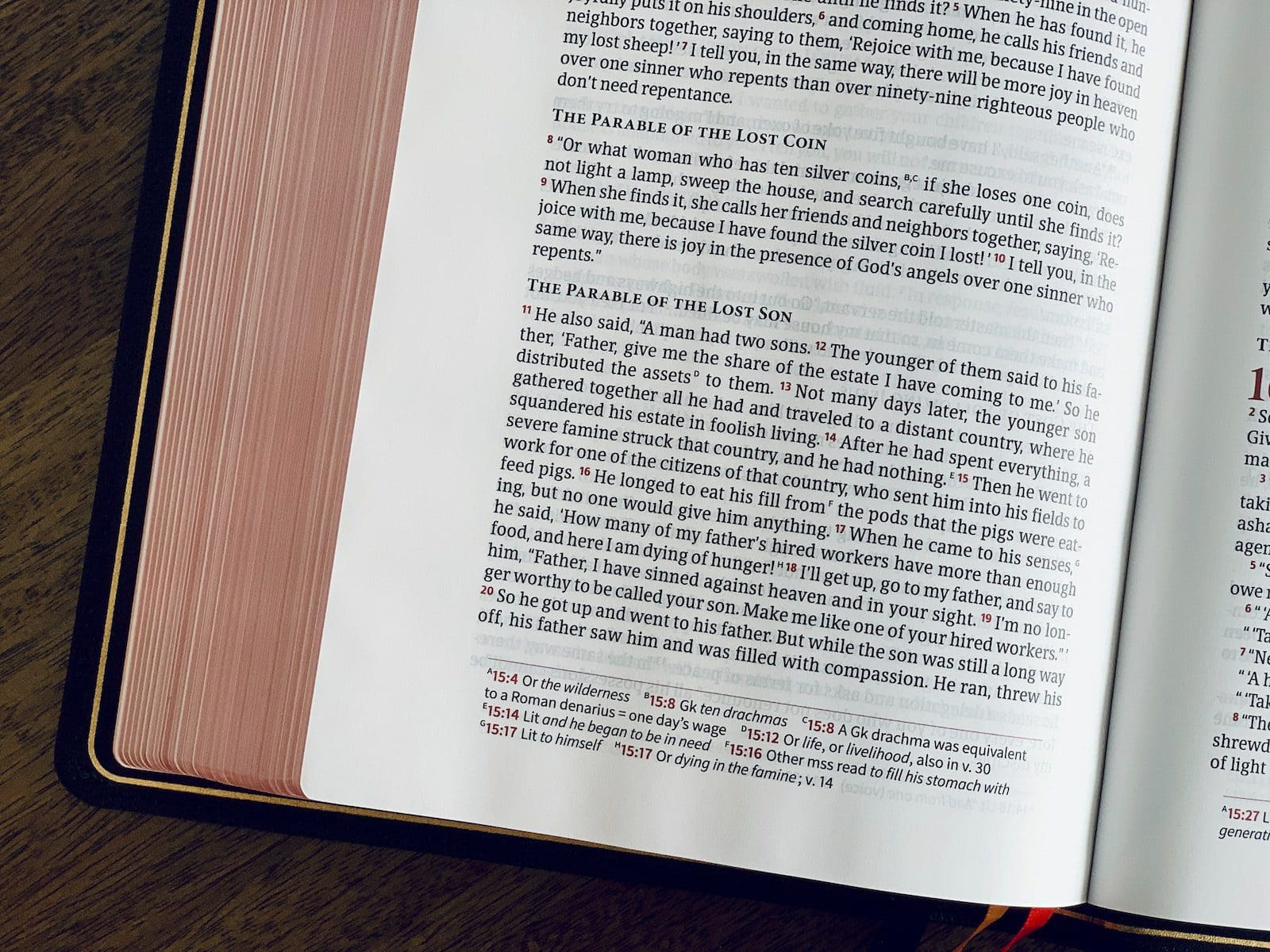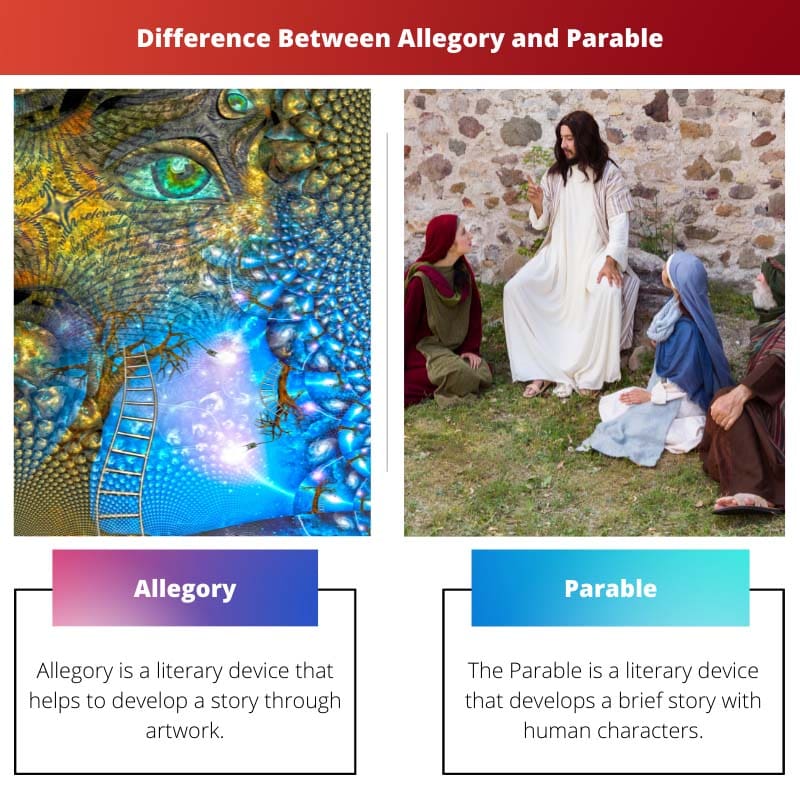Art is one of the most enjoyable things in nature. People used to teach morals to adults and children. Stories help to educate the morals where children show interest in learning. Allegory and Parable are the literary devices that describe the artwork of the story.
Key Takeaways
- Allegories are symbolic stories with a deeper meaning, while parables are simple stories that teach moral lessons.
- Allegories can be found in various forms of literature and art, whereas parables are specific to religious texts and teachings.
- Allegories are more complex and detailed, while parables are shorter and simpler.
Allegory vs Parable
The difference between Allegory and Parable is that Allegory is a literary device that uses the arts to develop a story. In Contrast, a Parable is a literary device that helps to explain a short story with morals. Allegory literary device work on artwork that reveals the hidden meaning of the artwork.

Allegory is a literary device that develops a story in the form of artwork. In Allegory, the story had narrated by using the characters, events, and places. In Allegory, Characters, events and places help in describing real-world issues in the form of stories.
Allegory is used to deliver a broad message to the world. Allegory helps the writers to create distance between themselves and the problems.
In Contrast, the Parable is a literary device that dictates the short stories. These stories deliver morals and principles to the world. Parables are different from fables, where fables use animals, plants, and inanimate objects to develop the story.
Parable devices use human characters to describe moral stories.
Comparison Table
| Parameters of Comparison | Allegory | Parable |
|---|---|---|
| Meaning | Allegory is a literary device that helps to develop a story through artwork. | The Parable is a literary device that develops a brief story with human characters. |
| Uses | Allegory uses the characters, places or events to develop a story. | Parable devices use human characters to develop a story. |
| Reveal | The allegory device reveals the hidden meaning of the story of the artwork. | Parable devices will teach the morals and principles through the short story. |
| Difference | Allegory works on artwork to describe the story that gives a broad message to the real world. | Parable devices had used to develop a short and brief story that illustrates one or more lessons and principles. |
| Examples | The Lion, the Witch and the Wardrobe is a religious allegory. | Bible and Quran are religious Parables. |
What is Allegory?
Allegory is a literary device that helps in developing the stories through artwork. Allegory devices use to narrate the story by using characters, places and events to deliver a message about real-world issues.
Allegory work on art reveals the hidden meaning of the artwork with morals. The stories of allegories describe the real problems in the world and their occurrences. Allegory had used to deliver a broad message to the world.
Allegory helps the writers to create distance between themselves and the issues. The issues had strongly analyzed politics and social realities. It is a short story that explains the lengthy points about society.
Allegory devices had used to explain the large and complex motives most simply. Some of the Characteristics of the Allegory are writer’s values, Multiple Meanings, Polarizing Relationships and Object Personification.
Allegories are different from metaphors, where metaphors had used to describe the speech with brief figures. The Allegory device conveys the whole story with characters. Allegories had differentiated into two types,
- Political or historical allegories
- The Allegory of Ideas.
The purpose of Allegories is the writer should convey the hidden meaning of a story through symbolic figures, characters, places, events, and actions. Some of the examples of Allegories are,
- Animal Farm
- The Faerie Queene
- The Frog and Nightingale
- The Scarlet Letter
- Lord of the Flies
The author is willing to convey the moral or political meaning through the above symbols. Allegories can write in sentences, poetry, literature, novels, movies and many others.

What is Parable?
The Parable is a literary device that helps to convey morals or principles through a short story. Parable had used to dictate the prose or verse with instructive morals. Parables use human devices to describe the stories.
Parable devices are different from Fables, where fables use animals, plants, and inanimate objects to develop the story. Parable devices use human characters to convey morals where readers can feel things with imagination while reading the stories.
The Parable is a Greek word that means ‘Comparison’. The Parable teaches a moral lesson that relates to society with a brief narrative. The parable also coveys the universal truth by using symbols, metaphors and similes in moral lessons.
The intentions of the Parables are to teach the morals, principles or lessons in a brief story that readers can understand easily. Primarily, Parable devices teach religious or moral stories. There are so many parables that had attributed to Jesus.
The Parables had distinguished into three groups they are Similitude, Parable, and Exemplary stories. The Exemplary story is also known as Illusions. The types of Parables are,
- Similes
- Extended Comparisons
- Similitude
- Example stories
- Narrative stories
- Non-Christian Parables
Similes are the short type of stories that develops to convey morals. Parables were primarily compact about Jesus in the 19th century. To covey the truth, Jesus used to teach the Parables in ancient days. Some of the examples of the Parables are,
- Bible
- Quran
- Parable of the Pearl
- The Farmers seeds
- Storytime with Jesus
- Two Sons
There are so many Parables, and the Parables taught by Jesus to live in the world with dignity. Bible and Quran are the religious Parables that people used to read. Parables will use to keep the people in the right way to reach their goals.

Main Differences Between Allegory and Parables
- Allegory is a literary device that conveys the story in the form of art. In contrast, Parable is a literary device that describes morals in the form of short stories.
- Allegory uses symbols, images, characters, places and events to develop a story, whereas Parable uses human characters to explain a story.
- Allegory works on art to describe the hidden meaning, and the Parable work on brief stories that convey morals.
- Allegory reveals the hidden meaning of the story, whereas Parables teach morals with brief stories.
- The writers create the distance to find the truth in Allegory, where Jesus had taught the parables.

- https://www.jstor.org/stable/1560206
- https://www.manchesterhive.com/downloadpdf/journals/bjrl/42/2/article-p273.pdf
- https://books.google.com/books?hl=en&lr=&id=P2UvmRVLF18C&oi=fnd&pg=PR11&dq=+Allegory+and+Parable&ots=gSYK28mZYk&sig=NRImRfSzvJ6ghy625XdBELctMbk

The comparison of allegory and parable was presented clearly. Both devices play an important role in conveying moral lessons, with allegories being more complex and detailed, while parables are simpler and shorter in their storytelling approach.
Indeed, allegory and parable each have their unique way of influencing readers and listeners through storytelling. This informative comparison helps us understand how both literary devices contribute to the art of storytelling.
The comparison table clearly outlines the differences between allegory and parable, especially in their meanings, uses, and the aspects they reveal. It’s essential to understand the distinction between these literary devices in storytelling.
I agree! The comparison table helps emphasize how allegory and parable are unique in their approaches to delivering messages and moral lessons through stories.
Well said! The definition of allegory and parable, along with their comparison, provides a clear understanding of their significance in literature and society.
Allegory and Parables are crucial to human society and culture as they have been used throughout history to teach morals through storytelling. Allegories represent a deeper level of symbolism and reveal hidden meanings, while Parables are more straightforward and seen in religious texts.
Great point! The different characteristics and uses of allegory and parable help shape the way stories are constructed and their impact on society. It’s fascinating to see how meaningful stories are developed through these literary devices.
Exactly! Both devices have been essential in educating people about morality and principles in an engaging and thought-provoking way.
The explanations of allegories and parables showcase their distinct traits and influence in literature and religious narratives. It’s remarkable to see how these storytelling devices are utilized to convey societal truths and moral lessons in diverse ways.
Well expressed! The differentiation between allegory and parable helps us appreciate the nuances of storytelling and the profound effect of these devices on shaping human perspectives.
Absolutely! The lessons and principles conveyed through allegories and parables reflect the enduring impact of these literary devices in shaping cultural and ethical values.
The insightful descriptions of allegory and parable clarify their functions and significance, especially in literature and storytelling. It’s fascinating to see how these devices shape the narrative structure to convey meaningful messages.
I couldn’t agree more! Understanding allegory and parable not only enriches our literary knowledge but also provides valuable insights into the historical and cultural context of storytelling.
The historical and contemporary examples of allegories and parables illustrate their enduring relevance in literature and the art of storytelling, providing valuable lessons and insights for readers and listeners.
The examples provided for allegories and parables highlight their significance in literature, including religious texts. The storytelling diversity between allegory and parable is interesting to note, especially in conveying moral lessons and societal truths.
Absolutely! The role of allegory and parable in communicating moral, political, and societal messages through stories reflects their timeless importance in literary works and religious scriptures.
Well put! The examples of allegories and parables show how these literary devices are used to engage readers and listeners in meaningful, thought-provoking narratives that resonate with human experiences.
The details about allegory, including writer’s values, multiple meanings, polarizing relationships, and object personification, demonstrate the intricacies of this literary device. It’s interesting to learn about the characteristics that shape allegorical storytelling.
Indeed! Allegory’s ability to convey complex motives and societal issues through symbolic storytelling is a testament to its impact on literature and the broader social context.
The insights on allegory and parable provide a comprehensive understanding of their purposes and uses. It’s fascinating to see how allegories create distance between writers and societal issues, while parables directly convey lessons through relatable human characters.
Absolutely! The examples given for both allegories and parables demonstrate their effectiveness in conveying meaningful messages to society through literature and religious teachings.
The distinction between allegory and parable is well-explained, shedding light on their different approaches to conveying moral messages. The depth of allegory and the succinctness of parable showcase the diversity of storytelling in literary works and religious teachings.